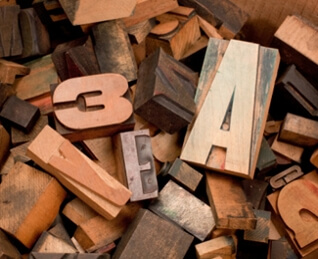 These days, most of us think nothing of dashing down to Kwik Kopy for a speedy run of digital printing. But there was a time not so long ago when smaller-scale personal or business printing was mostly unheard of. Save for newspapers, books and magazines, printing by hand was more often than not, the cheapest option for the documents, notes and flyers produced by deft-handed professionals back in the very early days.
These days, most of us think nothing of dashing down to Kwik Kopy for a speedy run of digital printing. But there was a time not so long ago when smaller-scale personal or business printing was mostly unheard of. Save for newspapers, books and magazines, printing by hand was more often than not, the cheapest option for the documents, notes and flyers produced by deft-handed professionals back in the very early days.
Although it is rare to spot even a dot-matrix printer now, much of the early history of printing has been preserved in the techniques we rely on today. With origins traced as far back as 3000 BCE, the earliest forms of printing are not entirely alien to modern technology. Providing the foundations for the machinery used in modern offset printing, Mesopotamian printers were using cylindrical rollers to press images into clay around 5000 years ago.
Woodblock printing, and block printing with other materials such as cast iron and clay, was used as the main printing method over the following millennium until movable type printing came about in China around the year 1040. Speedier and more reliable than its predecessor, movable type printing meant that uniform styles of fonts could be developed. Now, there are thousands upon thousands of different font styles available to graphic designers, with more created everyday.
While moveable type printing struggled to gain success in Asia due to the complexity of the characters required, it wasn’t until around 1439 that a German man, Johannes Gutenberg, developed a European equivalent. Famed for creating the first mechanical printing press using a combination of movable type and the machinery used for grape and olive pressing, Gutenberg was also instrumental in introducing the use of oil-based ink and is well known for printing the Gutenberg Bible: the book that began the publishing revolution.
The original-style Gutenberg printing press solved many previous printing problems, but it was still quite physically labour intensive. The development of the rotary printing press in the mid-1840s was a welcome advancement, bringing the style of machinery even closer towards the technology in use today. The modern offset printing press was created by American man Ira Washington Rubel in 1903.
By the mid 1900s, technology advanced rapidly and everything from photocopiers to commercial digital printers exploded onto the market. Even today, technology in this field is still progressing, and the techniques used for image reproduction are constantly being improved. Modern printing techniques used today include offset printing, digital printing, laser printing and ink-jet printing.
For advice and all the latest printing techniques, contact your local Kwik Kopy Centre. You can be sure Kwik Kopy will have the right design and print technology for your next printing project.
For more handy design and printing tips, head to your nearest Kwik Kopy Centre.

